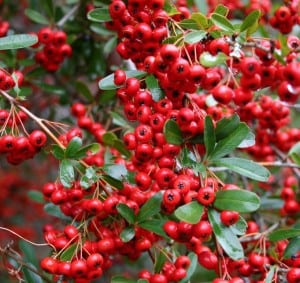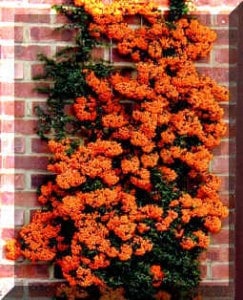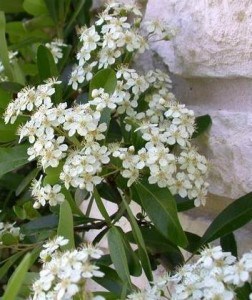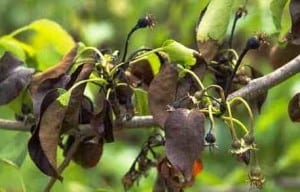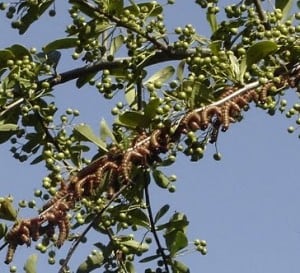Last updated on January 25th, 2022
Our site is reader supported, this means we may earn a small commission from Amazon and other affiliates when you buy through links on our site.
If you are looking for information on Pyracanthas, which is also more commonly known as Firethorn, then you are in the right place! Our website is full of detailed information and pictures on almost everything that you can think of related to this spikey evergreen shrub. We have information available about Pyracantha varieties, how to make Pyracantha jelly and how to plant a pyracantha hedge.
And best of all, it is totally FREE to use!
Pyracantha is an excellent shrub for planting in a variety of ways. It can be planted against a wall and then trained against it, or alternatively, you can plant several of them to create a dense, evergreen hedge.
Pyracantha plants produce fragrant white flowers during May and June, followed by red, orange or yellow berries in the autumn and winter (depending on the variety you have chosen). It will also attract wildlife into the garden, such as birds who love to feed on the berries throughout the winter. On top of this, the shrub will help to provide cover for nesting and roosting birds, as well as attract bees in the summer. Pyracanthas are easy to grow and require very little maintenance. They have small, glossy green leaves and are thorny, so be sure to put on a pair of protective gloves when planting and pruning them.
Pyracanthas berries are not poisonous (as many people think) although they are very bitter to taste. However, they are edible when cooked and are sometimes made into jelly.
Pyracantha Facts
- Botanical Name: Pyracantha.
- Common Name: Firethorn.
- Common varities: Pyrancantha Red Column, Pyracantha Orange Glow, Pyracantha Mohave.
- Planting time: Best planted from October when dormant, but they can be planted anytime of year if pot grown.
- Flowers: May – June.
- Berries: Autumn and Winter.
- Position: Full sun / partial shade.
- Planting area: Prefers fertile, well-drained soil although it will grow well in most soils.
- Size: Grows to approximately 300cm (10ft) (120″).
- Hardiness: Fully hardy.
Varieties of Pyracantha
There are many varieties of Pyracantha available, some of which include:
Pyracantha ‘Red Column’ (red berries), ‘Pyracantha Orange Glow’ (orange berries), Pyracantha ‘Mohave’ (orange/red berries) and Pyracantha ‘Soleil d’Or’ (bright yellow berries). These are varieties that are ideal for using to plant as a hedge or train up a wall or fence. They grow to approximately 10ft tall although they can be pruned to your required size, but be careful not to prune out the previous year’s growth as this is where most of the berries are produced.
Other varieties available, and ones that are supposed to be partially resistant to Pyracantha Scab (a common disease that affects Pyracanthas) are The Saphyr® range and the ‘Golden Charmer’, the ‘Orange Charmer’, the ‘Shawnee’ and the ‘Teton’ Pyracanthas.
Pruning and Training Pyracanthas
Pyracanthas are low-maintenance shrubs that are often used for training up walls or around frames and doors.
When it comes to pruning, it is important that you are careful not to prune off too much of last year’s growth. This is because Pyracantha flower upon the previous years’ growth in the summer, followed by berries in the autumn and winter. Pruning is best done when plants are in flower and this is so that you can prune back the flowers, allowing the berries to be on show later in the year. Using this method also reduces the number of flowering branches being pruned off.
If you are pruning a Pyracantha hedge then this should be done from spring and ideally up to three times a year to keep the hedge nicely trimmed to your desired shape. This, however, will make the hedge produce far fewer berries but there is not much else you can do if you want a tightly cut hedge.
To read more about pruning and training Pyracantha see our informative guide here.
Pyracantha Cultivation
Pyracanthas can be planted in most soil conditions as long as the site is not waterlogged. They do grow better in fertile, well-drained soil but they will also do well in dry or clay soils. Ideally, they are best planted in full sun to promote a heavy crop of berries, however, they will do fine in a partially shaded site but may not produce as many berries.
If you are planting Pyracanthas to be trained against a wall then plant the Pyracanthas approximately 30-40cm away from the wall. Pyracantha is strong enough to hold themselves against the wall but would probably benefit from being tied onto the wall. We recommend running wires alongside your wall and then tying the Pyracantha to the wires.
Pyracanthas can be planted in full sun or semi-shade and will grow well in most soil types, including clay and dry soil. They will thrive better in fertile, well-drained soil as this is their ideal growing condition. When planting, only plant to the same depth they have been previously planted and never plant further up the stem as this can damage the plant. Water plants regularly once they have been planted and do not allow them to dry out.
Do you want to read more about Pyracantha Cultivation? If so, check out our article here.
Common Pyracantha diseases, how to spot and control them
Pyracantha is prone to some diseases that can badly affect the plant if not treated at the first sign of disease. The two most common diseases associated with Pyracantha are Fireblight and Pyracantha Scab. Fireblight is a systemic disease that is spread by aphids, bugs, birds and even the wind and rain, so it is easily spread and can quickly spread from plant to plant. The disease is easy to spot as the affected leaves start to turn black and begin to crack as if it has been burnt by fire, which is where its more common name of Fireblight comes from.
Pyracantha Scab is not as serious as Fireblight but is very unsightly and it affects the blossoms and berries. These will start to turn black and appear scabby. It also causes the Pyracantha to drop the leaves and with the loss of the flowers and berries it can become disfigured. Pyracantha Scab is a fungal disease that is spread when fungal spores are spread to the plant by the wind, rain and by bugs and birds.
Read more about diseases that affect Pyracantha here.
Pests and the effects on Pyracantha plus how to treat them
Pyracantha has quite a few pests that they are susceptible to being attacked by. These include, Brown Scale insects, Aphids, Leaf Mining Moths, Caterpillars and Woolly Aphids.
The good news is that these all of these pests can be controlled using many different techniques. The most common one being spraying with a good garden insecticide that is available from most good nurseries and garden centres.
Read more here about pests, how they affect Pyracantha and how to treat them
How to plant a Pyracantha hedge
On average, hedging plants should be spaced between 2–3ft (60-90cm) apart and the hedge made up of a single row. If you want a thicker hedge, you will need to use more plants, planted in double staggered rows. These rows will need to be spaced 70-100cm apart, with 60-90cm between each plant in the two rows. A single row Pyracantha hedge can form a 4ft wide hedge using this method so it isn’t very often doubles rows are planted with Pyracantha
“A general rule of thumb is that plants need to be spaced so that they are just a few inches from touching on either side.”
These instructions are as a guide only and are ideal for planting Pyracantha that is 1-3ft (30-90cm) tall. If you are planting larger plants then you may need to alter the trench size etc to accommodate the plants.
Planting a hedge
Before planting a hedge you will first need to dig a trench the full length of what you want your new hedge to be. This needs to be approximately 60cm (2ft) wide and 40-50cm deep. If you are planting larger plants you will need to alter the width and depth of the trench accordingly. If you are planting a double hedge you will need to increase the width of the trench to approximately 90cm (3ft) wide. Simply place the soil to the side of the trench (so that you can backfill afterwards) and remove any weeds or large stones.

